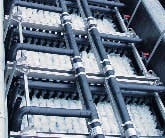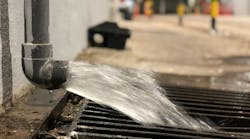An innovative dual-stage membrane bioreactor (MBR) for advanced treatment of industrial wastewater delivers a higher quality effluent in less space and with lower operating costs than are normally associated with conventional activated sludge processing system. The new ITT Industries systems take advantage of synergies between two of its subsidiary companies: Sanitaire and Aquious - PCI Membrane Systems. Aquious is a new brand that envelopes ITT Industries' existing membrane filtration products and technology, including PCI Membrane Systems, Inc., Milford, OH. Sanitaire, Brown Deer, WI, is known for innovative wastewater treatment technologies used in municipal and industrial wastewater treatment facilities.
Targeted at industrial wastewater applications in food & beverage production, chemical and pharmaceutical manufacturing, pulp and paper processing, metal finishing and steel production, the Aquious Dual-Stage MBR system is a complete and continuous process. It accepts wastewater with high loadings of BOD, suspended solids and other contaminants and yields an excellent quality effluent that can be suitable for direct discharge to surface water bodies (depending on local regulations) and “low grade” re-use applications such as vehicle washing. The water can be further treated with polishing processes (for instance, reverse osmosis) to yield potable water.
The new Dual-Stage MBR system offers several other benefits:
• Reliability — Simple-to-operate barrier technology, ensuring consistently high effluent quality
• Compactness — the intensive nature of the process minimizes space requirements
• Robustness — resistance to shock effluent loads
• Reduced sludge — the production of solid waste is reduced, limiting disposal costs
• Economy — advanced aeration and membrane technology minimize power demand.
In a traditional activated sludge process, wastewater is introduced into a biological treatment tank where organic contaminants are reduced and nutrients removed. The resultant biomass or sludge then flows to a clarifier or settling tank where solids separate out and effluent can be taken off and filtered prior to disinfection. If higher levels of effluent quality are required before disposal or re-use, an additional microfiltration or ultrafiltration step may be required.
Membrane bioreactors, on the other hand, use the physical barrier provided by an ultrafiltration membrane instead of a settling tank to separate solids from liquid. Thus the effluent is of significantly higher quality and little, if any, additional treatment is required prior to disposal or re-use.
In the new Aquious Dual Stage MBR system, the biological treatment portion of the process is kept separate from the membrane filtration stage. Each stage of the process can then be operated at its optimum condition. Critical parameters such as aeration rate can be controlled discretely to minimize cleaning and power costs. In addition, this configuration provides flexibility that allows standard designs to be tailored to suit the specific requirements of different industrial wastewater types.


